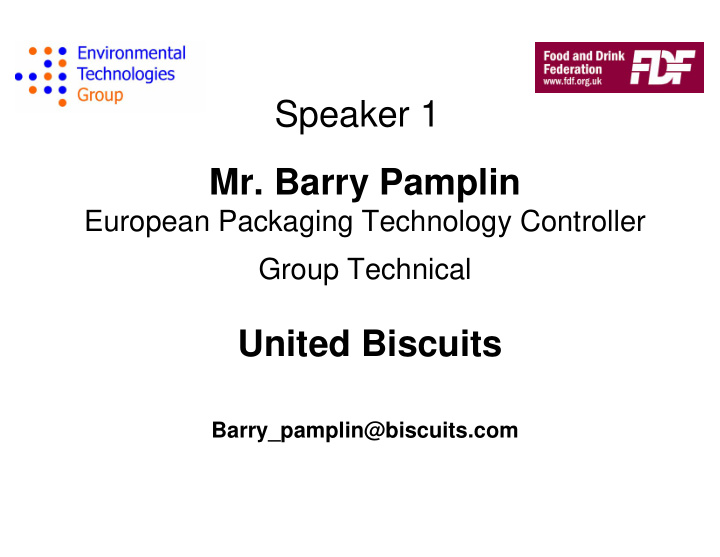



Speaker 1 Mr. Barry Pamplin European Packaging Technology Controller Group Technical United Biscuits Barry_pamplin@biscuits.com
Best Practise in Reduce Recycle and Reuse. A Food Manufacturers Perspective
Agenda What is best practise? Reduce, Recycle and Reuse. Balancing the needs. UB’s current approach
Best Practise the Dilemmas What is best practice? It depends on the goals you are trying to achieve I am confused so what about the consumer It appears that there is a counter argument of almost any action you take
Best Practise the Dilemmas Reduce All food manufacturers have been working on the reduce goal for a number of years. It is cost reduction by another name. What is different this time is that the consumer and customer are demanding it. There is less marketing resistance, now being used as a marketing position and strategy Global price rises and inflationary pressures are adding to the need to reduce costs
Best Practise the Dilemmas Reduce Dare to be different. Compare with your competitors but make difference a virtue. Take time to test and study, do not be afraid to revisit previous “failures” Inform the consumer what you are doing. Look at the total pack performance not individual layers in isolation. Combine functions but this can prevent recyclability
Best Practise the Dilemmas Recycle Theory vs. practise. We must guard against the use of theoretical recycling and what is happening in practise. The material must be easily recognisable, easily separated and recycled. Clear and standardised logos and iconography are essential. How do we achieve this on an increasing cluttered pack? Balance the need to make a material recyclable with the lightest weigh of packaging material required. Is it really better to have a heavy recyclable component when it could be light weight and non recyclable?
Best Practise the Dilemmas Reuse Currently reusable primary packaging is confined to internal use. Traditionally some sectors, fruit and veg, bakery have used returnable secondary packaging. These closed loop systems work well. They are managed by our customers. For the consumer we must give easy options for reuse/refilling and an alternative minimised pack. It must be obvious that it can be refilled. The refill must be positioned with the refillable pack. The issues arrive if we have reusable packaging for our consumers. Food safety Theory vs. Practise for reuse
Best Practise the Dilemmas Balancing The Needs Environment For the manufacturer there is a lot of confusion here. What is best for the environment. Unfortunately this has increased by some ill-informed and miss leading information in the press and media
Best Practise the Dilemmas Balancing The Needs Food Safety As the demand for recycled materials increase, especially plastics so the demand for feedstock increase. This can lead to a reduction in fed stock quality We must not have any possible contamination issues. One product / health scare will destroy the demand As a responsible food producer we must guard against these risks
Best Practise the Dilemmas Balancing The Needs Product Protection We must protect our products from moisture and oxygen. There are a limited number of materials that can do this. Currently we achieve this by enhancing the performance of plastics films with coatings and barriers. Recycled board does not always give the same physical protection as virgin board. Product protection is paramount. Any gains in packaging reduction or ease of recycling are destroyed by increased food waste. Consumers will still demand prefect products.
Best Practise the Dilemmas UB’s Current Approach Reduce. Our main aim is to reduce the amount of packaging we use An average roll pack weighs 2g for 200-400g of product. The average weight for all our wrappers is 3g Most of our primary wrappers are less than 40 micron thick. That is less than half the thickness of a human hair!. We have reduced the amount of packaging we use per tonne of product since 2003 by 7%. But… our wrappers are not currently recyclable
Best Practise the Dilemmas UB’s Current Approach Recycle. We have a policy of using recycled material where we can. Cartonboard - >95% or our cartons use recycled board Corrugated - >70% recycled content Tins - up to 51% recycled content 80% by weight of all the packaging we use is recyclable. This will increase when and if we can increase the use of recycled plastic trays rPET We estimate a high percentage of that is recycled because it is transit packaging that is recycled by the retailers.
Best Practise the Dilemmas UB’s Current Approach Reuse . We have a large amount of reusable packaging most of which is internal movement of products. Some of our seasonal packs, tins and plastic tubs are reusable. We are introducing more re-usable packs and re fill packs. .
Best Practise the Dilemmas Current Issues. Which is most important, reduce, recycle or reuse? Food Waste / Safety are key issues. Poor communication to the consumer about the issues. How does the consumer compare product to product? Consumers will still demand prefect products. Energy from waste?
Recommend
More recommend